Experience More
Set in a pleasant hillside garden, this museum showcases the private collection of the late chairman of the Tokyu Corporation, Keita Gotoh. He was originally attracted to Buddhist calligraphy (bokuseki), and his collection contains many examples of this work. Also included are ceramics, paintings, and metalwork mirrors.
The museum’s most famous works, however, are a set of 12th-century scrolls featuring scenes from the Tale of Genji, painted by Fujiwara Takayoshi, which have been designated National Treasures. They are shown once a year, usually during Golden Week (April 29–early May). The museum is closed during summer maintenance, when exhibitions change over.
Did You Know?
The Tale of Genji, by Lady Murasaki, is thought to be the world’s first novel.
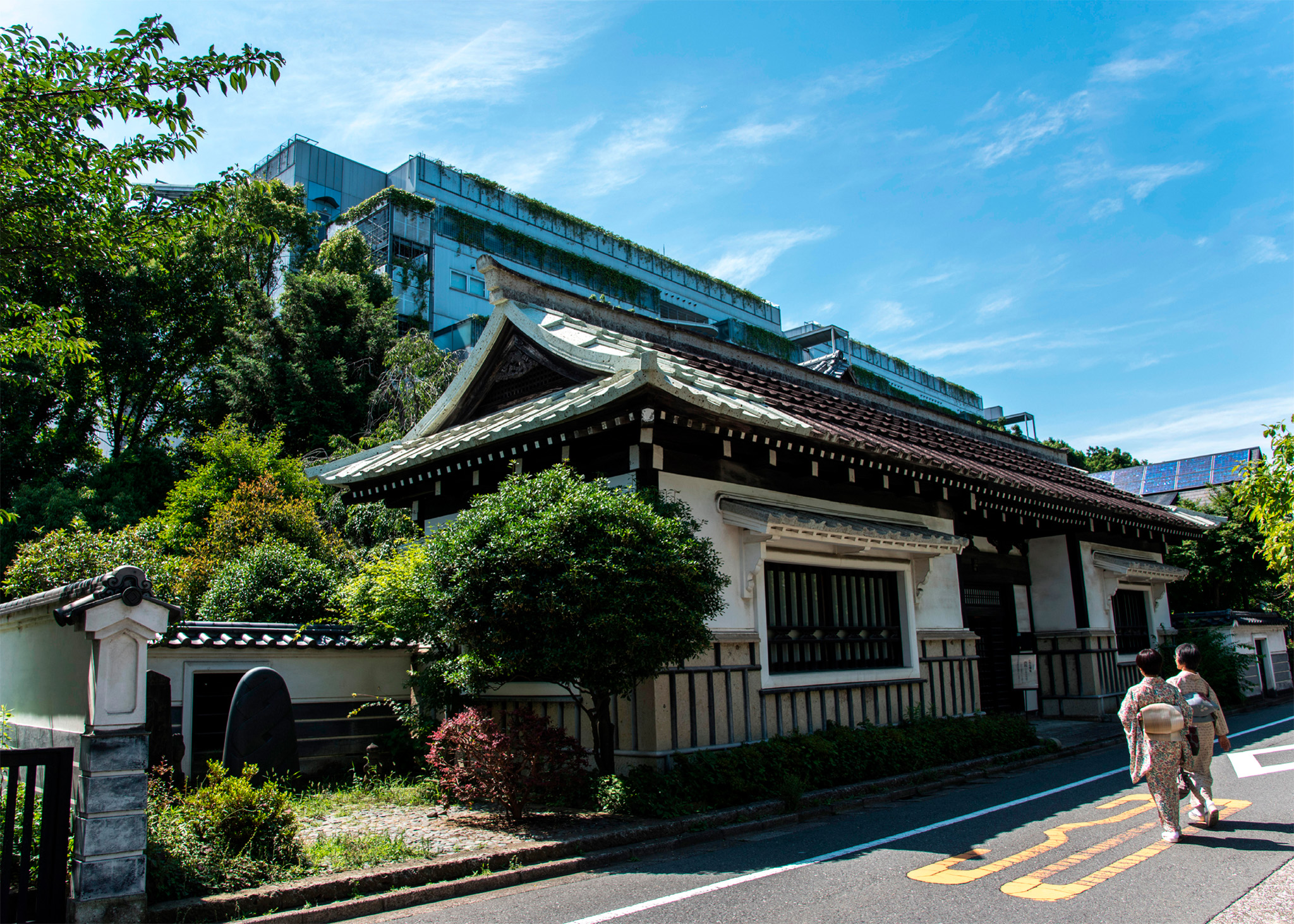
t Exterior of the Japan Folk Crafts Museum, designed by its art-historian founder
Known to the Japanese as Mingeikan (mingei meaning “folk crafts”), this small but excellent museum was set up by art historian Soetsu Yanagi. Yanagi valued the simple and utilitarian nature of hand-made, everyday objects, and started the mingei movement to preserve such designs in the era of mass-production. The criteria for inclusion in the museum’s collection are that the object should be the work of an anonymous maker, produced for daily use, and representative of the region from which it comes. On display are a huge variety of items, including woven baskets to axe sheaths, iron kettles, pottery, and kimonos. There are also themed exhibits, such as 20th-century ceramics, tie-dye techniques or Japanese textiles, and a room dedicated to Korean Yi-dynasty work. A small gift shop sells fine crafts.
EXPERIENCE Beyond the Center
|
Drink Belg Aube Toyosu A café with a good range of Belgian beers and European dishes. ⌂ LaLaport Toyosu 1F, 2-4-9 Toyosu, Koto § (03) 6910-1275 Hops125 One of Tokyo’s most exciting craft beer venues, Hops125 features a diverse array of local and international beers, with more than 10 on tap at any time. ⌂ 1 Chome-21-18 Ebisu, Shibuya § (03) 3447-1496 Spring Balley Brewing The beers on tap at this cool brewpub include everything from crisp pils and IPAs to experimental fruit beers. ⌂ Log Road Daikanyama, Daikanyamacho, Shibuya § (03) 6416-4960 |
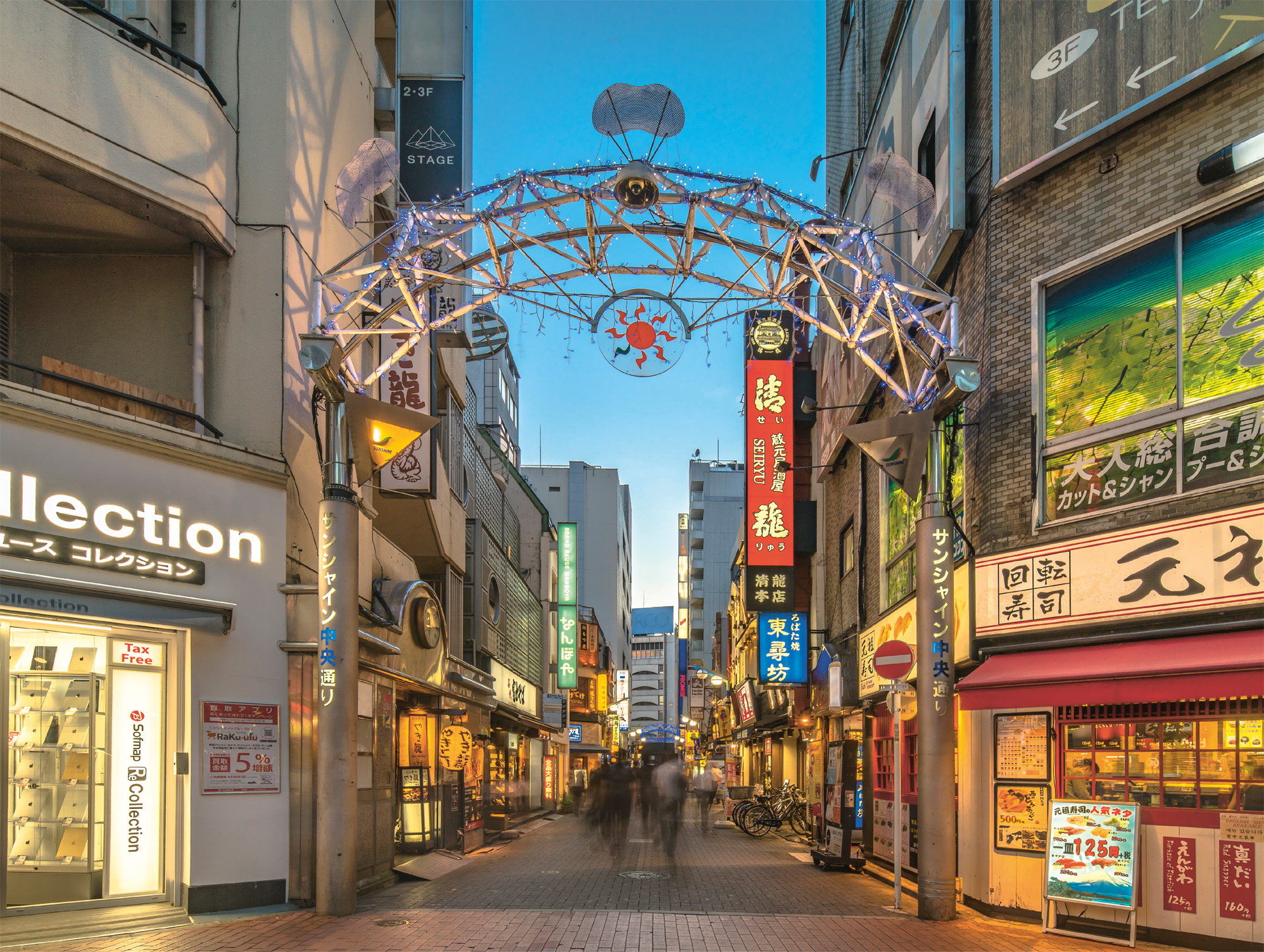
t The illuminated entrance gate to the Sunshine City mall, with its numerous restaurants and shops
Ikebukuro has become one of Japan’s most popular otaku (geek) districts. Here you’ll find the flagship store for the country’s biggest anime goods retailer – Animate – as well as several locations of their Animate Cafe, where the anime-themed decor, menu, and exclusive merchandise change every few months.
While Tokyo’s most famous geek district, Akihabara, is more popular with men, Ikebukuro is frequented mostly by women, as many of the stores in the area focus on media with a large female fanbase. The district even has a butler café (www.butlers-cafe.jp) in place of Akihabara’s typical maid versions.
But even non-otaku will enjoy exploring this lively leisure district, which is full of shops, arcades, bars, and restaurants. Thre’s also the incredible Sunshine City mall, which has an aquarium, observation deck, and amusement park, plus a long list of stores and restaurants. With all of this activity, the Ikebukuro district has firmly earned a spot on the map of cool Tokyo highlights.
Sunshine City
⌂ 3-Chome-1 Higashiikebukuro # Times vary, see website ∑ sunshinecity.jp
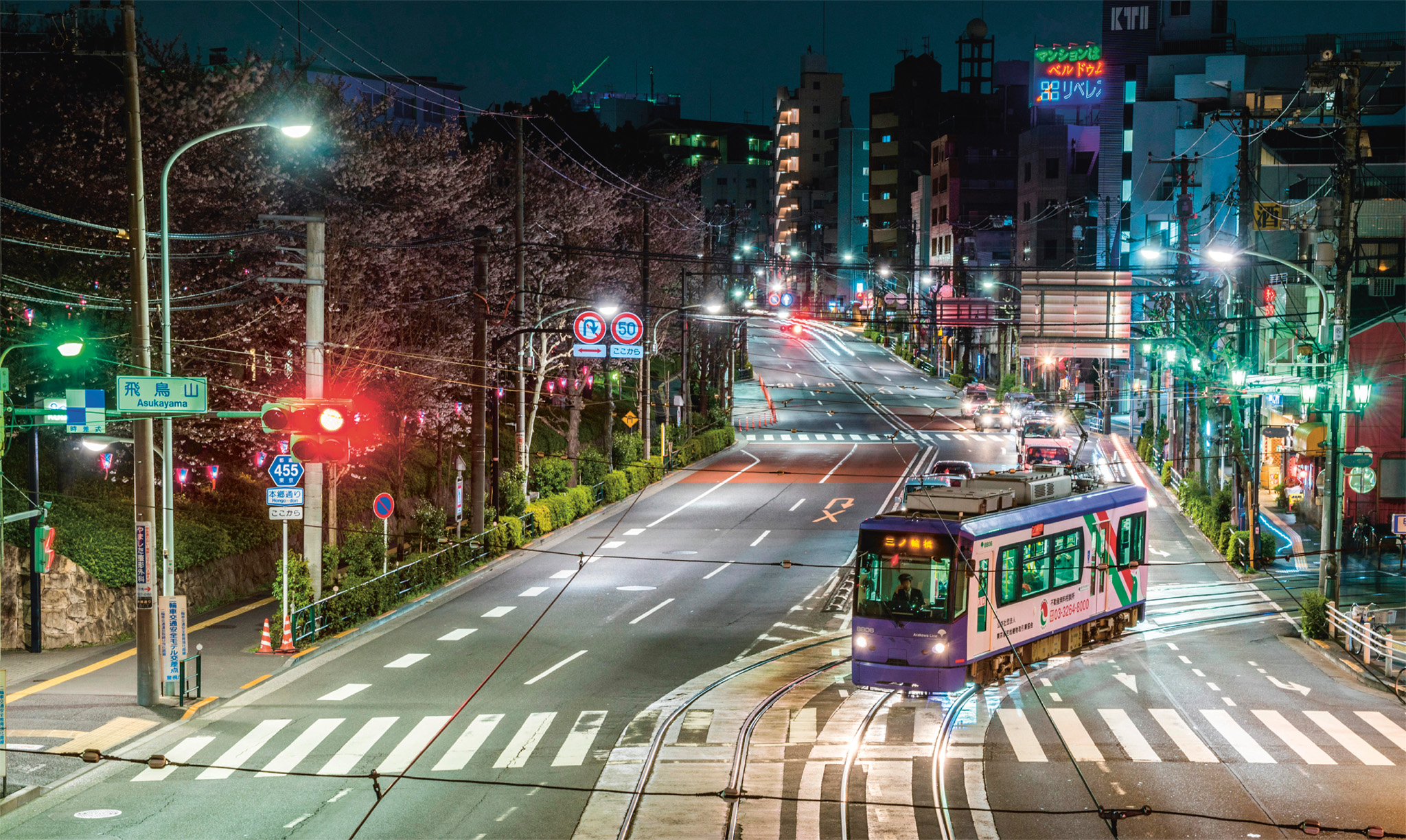
t A tram trundling along the Arakawa Tram Line at night
In 1955, 600,000 people a day were riding the dozens of tram lines that crisscrossed the city. Now the 8-mile- (13-km-) Toden-Arakawa line is one of only two that remain, along with the privately-owned Tokyu Setagaya line. The others were eliminated as old-fashioned in the modernization for the 1964 Olympics.
The Toden-Arakawa line runs from Waseda in the west to Minowabashi in the east and costs ¥170 for each trip. The tram itself is a Tokyo highlight, and there are also lots of interesting places to explore along the route. Near the Waseda end of the line is the Higo-Hosokawa Teien stroll garden. A short walk from Arakawayuenchi-Mae stop is the Arakawa Yuen Amusement Park (closed for renovations until 2021). Opposite the Arakawa-Nanachome stop is the tranquil Arakawa Nature Park.

t Yebisu Garden Place, a chic commercial center in Ebisu
In 1994 the completion of Yebisu Garden Place – a commercial and residential center – brought this area to life. The Tokyo Photographic Art Museum has a permanent collection of work by Japanese and foreign photographers. In the center are a Mitsukoshi store, numerous boutiques, two cinemas, a theater, and restaurants. To the left of Mitsukoshi is the small Yebisu Beer Museum containing exhibits and videos about beer worldwide and in Japan, plus free samples.
"
Tokyo Photographic Art Museum
⌂ 1-13-3 Mita, Meguro # 10am–6pm Tue–Sun (to 8pm) ∑ topmuseum.jp
'
Yebisu Beer Museum
⌂ 4-20-1 Ebisu, Shibuya § (03) 5423-7255 # 11am–7pm Tue–Sun
Did You Know?
The Ebisu district was named after the Yebisu Beer brand.
This is the site of the climax of Japan’s favorite tale of loyalty and revenge, retold in the play Chushingura and many movies. Lord Asano was sentenced to death by seppuku (ritual disembowelment) for drawing his sword when goaded by Lord Kira. Denied the right to seek revenge, 47 of Asano’s retainers (or ronin), led by Oishi Kuranosuke, plotted in secret. In 1702, they attacked and beheaded Kira, presenting the head to Asano’s grave at Sengaku-ji. They in turn were sentenced to seppuku and are buried here. Inside the temple gate is the well where the ronin washed Kira’s head. Farther ahead on the right are the retainers’ graves. Back at the base of the steps is an interesting museum with artifacts from the incident, which you can visit for a fee.
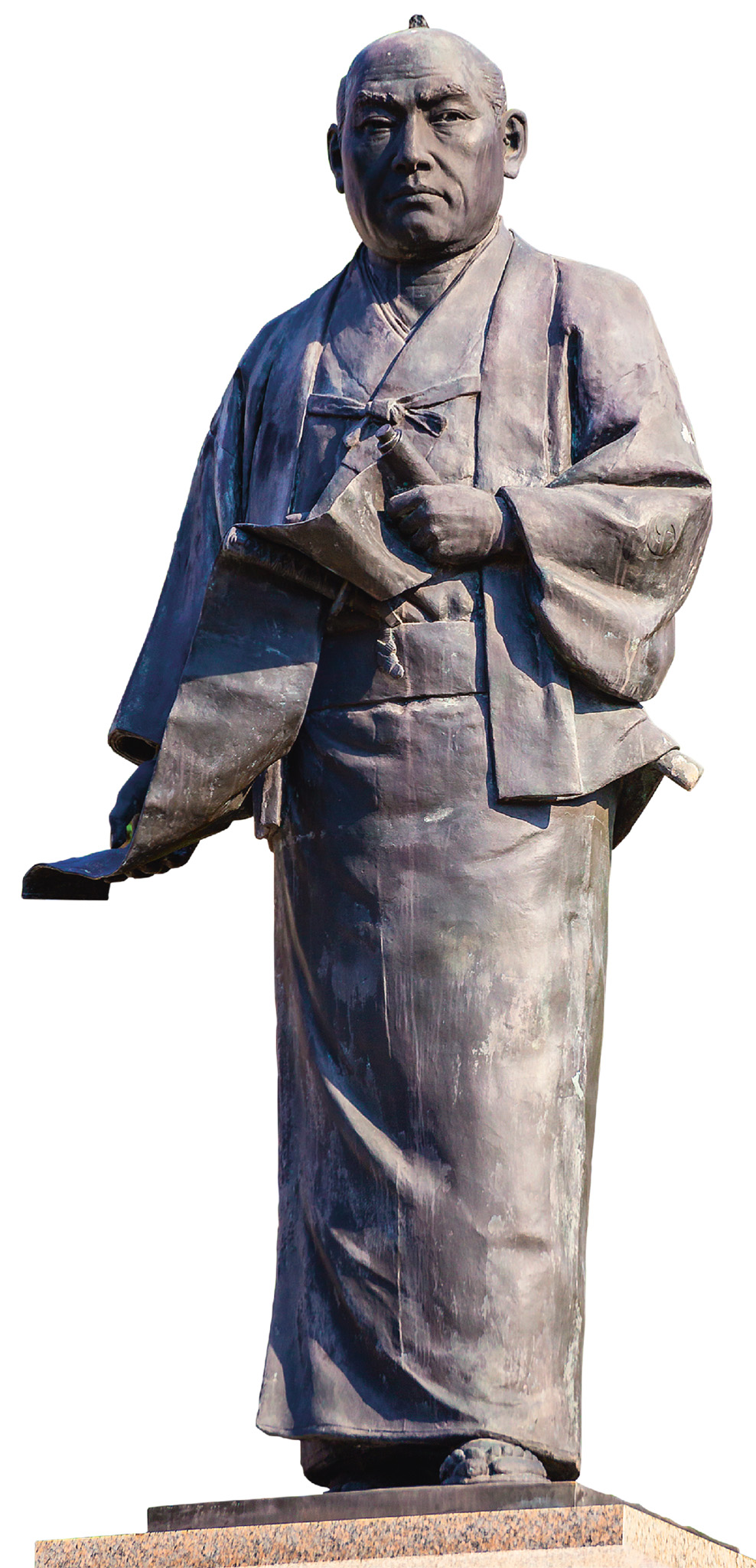
t Statue of ronin leader Oishi Kuranosuke at Sengaku-ji
Studio Ghibli is known throughout the world for its wonderful animated films – some of them charming coming-of-age tales, and others high fantasy epics. The museum makes fans feel as if they have stepped straight into a Ghibli setting, with the studio’s trademark style and attention to detail evident throughout thr grounds. Among the many nooks and crannies to explore are the cinema showing short animated films exclusive to the museum, a fascinating replica of an animation studio, and a café with themed treats. Children will also enjoy letting off steam in the play area inspired by My Neighbor Totoro. Make sure to book your tickets well in advance.
EXPERIENCE Beyond the Center
|
SHOP Animate Nine stories full of new, official anime products. ⌂ 1-20-7 Higashiikebukuro ∑ animate.co.jp/shop/ikebukuro Pokémon Center Mega Tokyo Everything you need to fill your life with Pokémon. ⌂ Sunshine City Alpha, 3-1-2, Higashiikebukuro ∑ pokemon.co.jp/gp/pokecen Village Vanguard Exclusive goods from the ichiban kuji lottery: a prize-draw for all kinds of otaku goods. ⌂ Sunshine City Alta, 3-1-3, Higashiikebukuro ∑ village-v.co.jp/shop/detail/958 K-Books A used goods retailer with thirteen locations in Ikebukuro. Each one has a different focus, such as sports anime, cosplay or voice actors. |
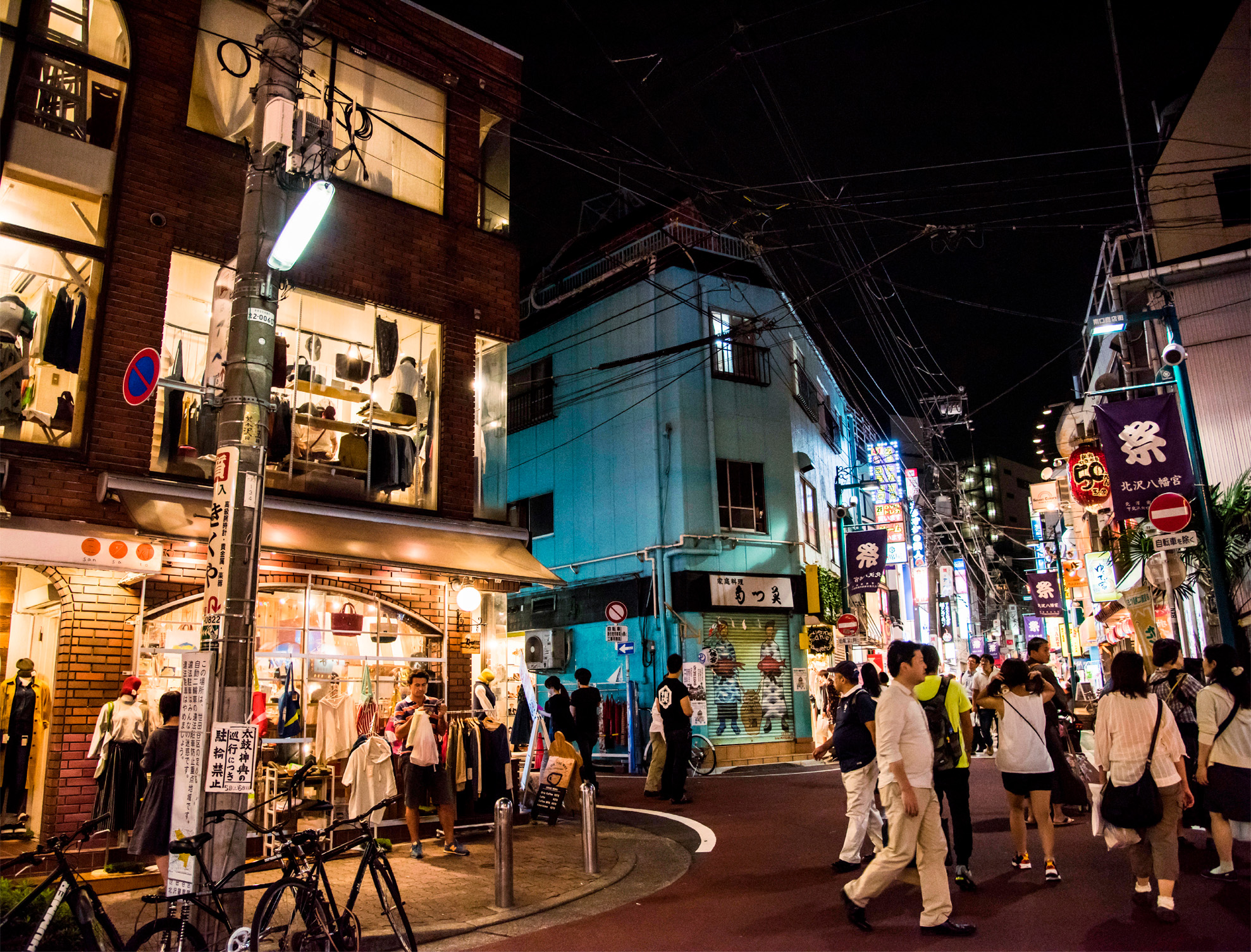
t People enjoying the cool, alternative vibe of the Shimokitazawa district
More popularly known as Shimokita, one of the most distinguishing characteristics of this area is its cool, alternative atmosphere, giving Shimokita a reputation as a real hispter haven.
The seeds of the this relaxed image were sown in the 1960s when a number of small fringe theaters opened here. Some of these still operate today, and more have been added over the years to create a thriving drama scene. The best and most famous venue is the Honda Theater, which provides small but convivial spaces for modern, experimental productions.
Shimokitazawa’s north side is full of record stores, vintage clothing boutiques, and international restaurants. Its independent cafés are especially famous, earning fans from far and wide. The south side, meanwhile, is renowned as the trend-setting center of Tokyo’s music scene. Home to an incredible number of music venues, this is the place to enjoy a Japanese institution known as the “live house”. These intimate live music venues are where patrons come to enjoy music in peace, rather than to drink and socialise as at many other bars.
Honda Theater
⌂ 2-10-15 Kitazawa ∑ honda-geki.com

Insider Tip
Shimokita’s Coffee Shops
Some coffee shops in Shimokitazawa celebrate the relaxed, social aspect of coffee breaks, and are great places to sit and people watch. Others take coffee so seriously that customers are forbidden from taking photos of their drinks.
An important archaeological site, where well-preserved burial mounds and ancient pit dwellings have been discovered, Daikanyama is better known these days as a classy, low-rise neighborhood. It is more popular with the smart set, who come here to explore its trendy boutiques, restaurants, patisseries, and alfresco pavement cafés.
Some big name international fashion brands, such as Jean Paul Gaultier, have outposts here, adding more class and distinction to an already chic district. The area, with its back lanes, shops, and home courtyards full of greenery, makes for a pleasant stroll. Interest in the area first grew when Japanese architect Fumihiko Maki began his ongoing Hillside Terrrace, an apartment, gallery, and shopping project along leafy Kyu Yamate-dori, in 1969. Buildings have been added over the decades. The Art Front Gallery hosts interesting art exhibitions, while closer to the station Daikanyama Address Dixsept complex houses boutiques and trendy cafés. Another major addition came in 2011 with the multiple-design-award-winning Daikanyama T-Site complex, a sleek combination of book store, café and even dog salon, among other things.
Art Front Gallery
§ (03) 3476-4868 # 11am–7pm Wed–Sun
Daikanyama T-Site
§ (03) 3770-2525 # 7am-2am daily
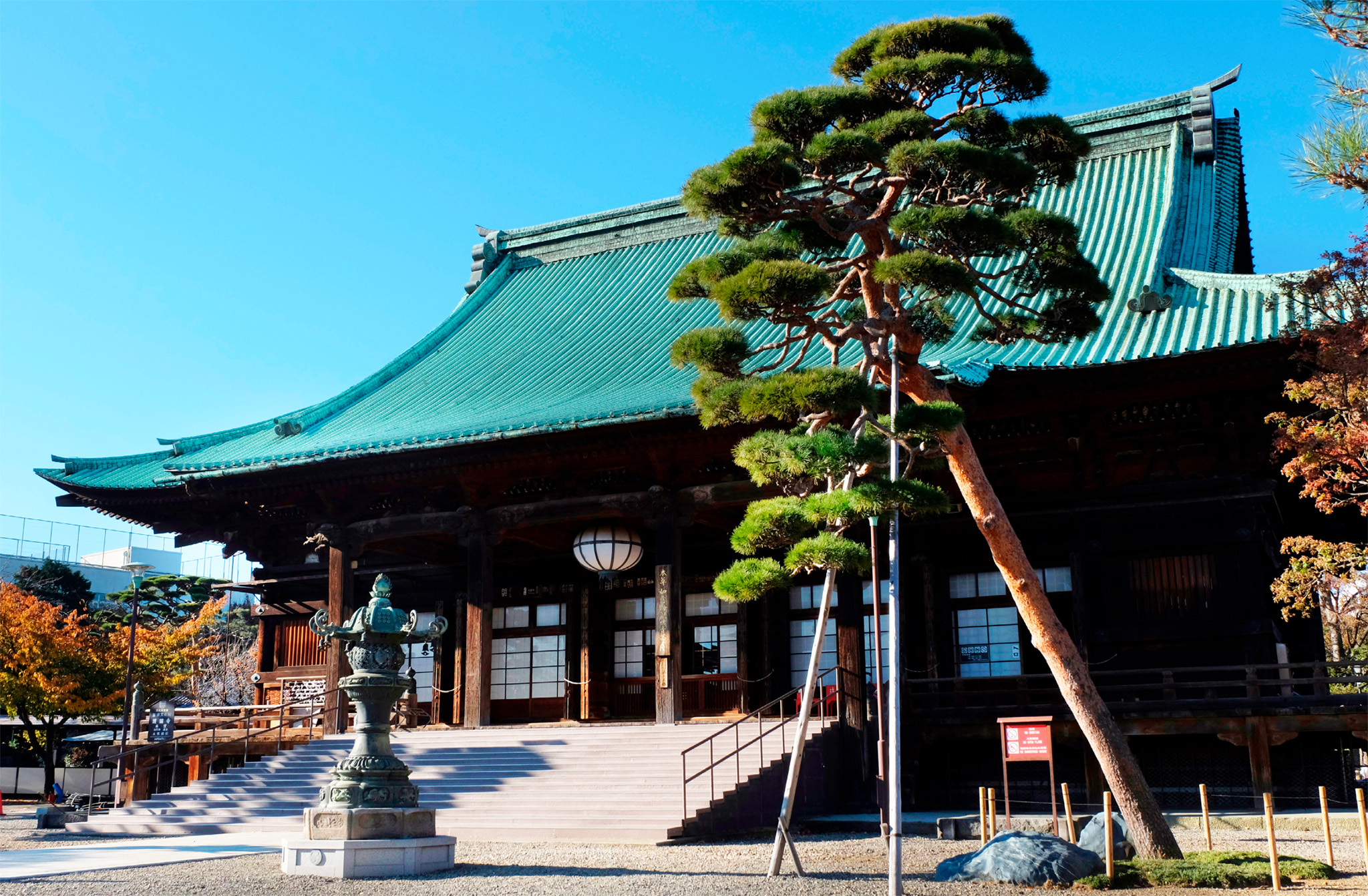
t one of Edo’s most important temples
Little-visited Gokoku-ji is one of Edo’s most important temples. Before entering the spacious grounds of the temple, visitors pass through the arresting Niomon gate. The gate takes its name from the statues of two fierce-looking, red-faced Deva kings positioned at either side of the entrance. The statues are meant to ward off malevolent spirits. The right-hand figure’s mouth is open, while his companion’s is closed. This symbolizes exhalation and inhalation, creation and dissolution; the harmony of opposites encountered in many of Japan’s arts.
Stunningly well preserved, the complex’s main hall, dating from 1681, with its sweeping copper roof and massive pillars, is a treasure house of Buddhist statuary. Foremost among the deities here are Kannon, the goddess of mercy. Eight celestial maidens dance across the ceiling in paintings that float over transoms covered with colorful carvings of peonies.
Completing the ensemble of buildings that have been designated Important Cultural Properties are an imposing bell tower and a rare two-tiered pagoda, a popular subject for painters.

t Surprisingly little-visted Gokoku-ji
EXPERIENCE Beyond the Center
|
EAT Tokyo Ramen Kokugi-kan Six ramen shops offering Sapporo-style miso ramen, Hakata-style tonkotsu (pork bone) ramen, and more. ⌂ Aqua City Odaiba 5F, 1-7-1 Daiba, Minato § (03) 3599-4700 Odaiba Takoyaki Museum Stalls dish up variations on the classic fried batter and octopus balls, a regional dish from the southern city of Osaka. ⌂ Decks Tokyo Beach, 1-6-1 Daiba, Minato ∑ odaiba-decks.com/en/takoyaki |

t The Fukagawa Edo Museum, which recreates an area of 19th-century Fukagawa
This area is situated east of the Sumida River and squarely within what was known as Shitamachi. It took centuries to reclaim the land from Tokyo Bay and the estuary. To get a good historical grip on the neighborhood, visit the Fukagawa Edo Museum. It recreates an old area of Fukagawa circa 1840, with 11 original buildings, homes, shops, a theater, boathouse, tavern, and a 33-ft- (10-m-) high fire tower. The interiors of the houses have an authentic atmosphere with fishing nets and workmen’s clothing casually hung on the walls, and empty shells strewn on the floor of a reproduced clam peddler’s home.
Fukagawa has several lovely outdoor spaces to enjoy when you need a break from exploring the city streets. First, spanning a vast space either side of the small Sendaibori River, Kiba Park is home to the Museum of Contemporary Art, which reopened in 2019 after undergoing major improvements. The rest of the park – with its botanic gardens, tennis courts, barbecue area, and lawns for strolling – is the ideal place to relax with the family. Only 15 minutes away, built within the grounds of a large estate in the area of present-day Kiyosumi Shirakawa, the Kiyosumi Teien is a beautifully landscaped garden. The grounds are a classic Edo-era kaiyushiki teien, or “pond walk around garden,” with plants that bloom at different times of the year. A teahouse, which floats above the water, and 55 rare stones, brought from all over Japan by Mitsubishi steamships, are the highlights of this garden.
North of Kiyosumi Teien, the small neighborhood of Kiyosumi has won fame for its many high-quality independent coffee shops. If you can’t live without flat whites or pour over coffees, make sure to pay a visit to one of the many cafés here.
In nearby Monzen Nakacho, the Tomioka Hachiman-gu shrine dates from the 17th century. The current building is a 1968 reconstruction, but its prayer and spirit halls and the copper-tiled roof are very impressive. The famed Flea Market, the Fukagawa ennichi, is another attraction. This lively event is held in the shrine grounds on the first, second, and fourth Sundays of the month, from around 6am to sunset.
Fukagawa Edo Museum
⌂ 1 Chome-3-28 Shirakawa, Koto § (03) 3630-8625 # 9:30am–5pm daily ¢ 2nd & 4th Mon
" - =
Museum of Contemporary Art
⌂ 4 Chome-1-1 Miyoshi, Koto # 10am–6pm Tue–Sun ∑ mot-art-museum.jp
Kiyosumi Teien
⌂ 1 Chome-3-16 Kiyosumi, Koto § (03) 3641-5892 # 9am–5pm daily
MATSUO BASHO
In 1680, Japan’s most famous poet, Matsuo Basho (1644–94), moved to the then inaccessible backwater of Fukagawa. At that time, there were no bridges crossing the Sumida River, and Basho could finally escape his admiring public and achieve the isolation he needed to focus on his writing. It was Fukagawa that served as a base for some of his most famous journeys, and where he wrote his famous frog haiku.
In addition to Rikugi-en Garden, the district of Komagome has another garden of note: Kyu Furukawa. Its main building, a charcoal-grey stone residence designed by British architect Josiah Conder in 1917, resembles a small Scottish manor house. To see the interior, you need to book in advance (www.otanimuseum.or.jp/kyufurukawatei).
The mansion and its English-style rose garden sit on a ridge above steps leading down to a landscaped area, replete with a tea-ceremony pavilion and a small waterfall that feeds into a heart-shaped pond.
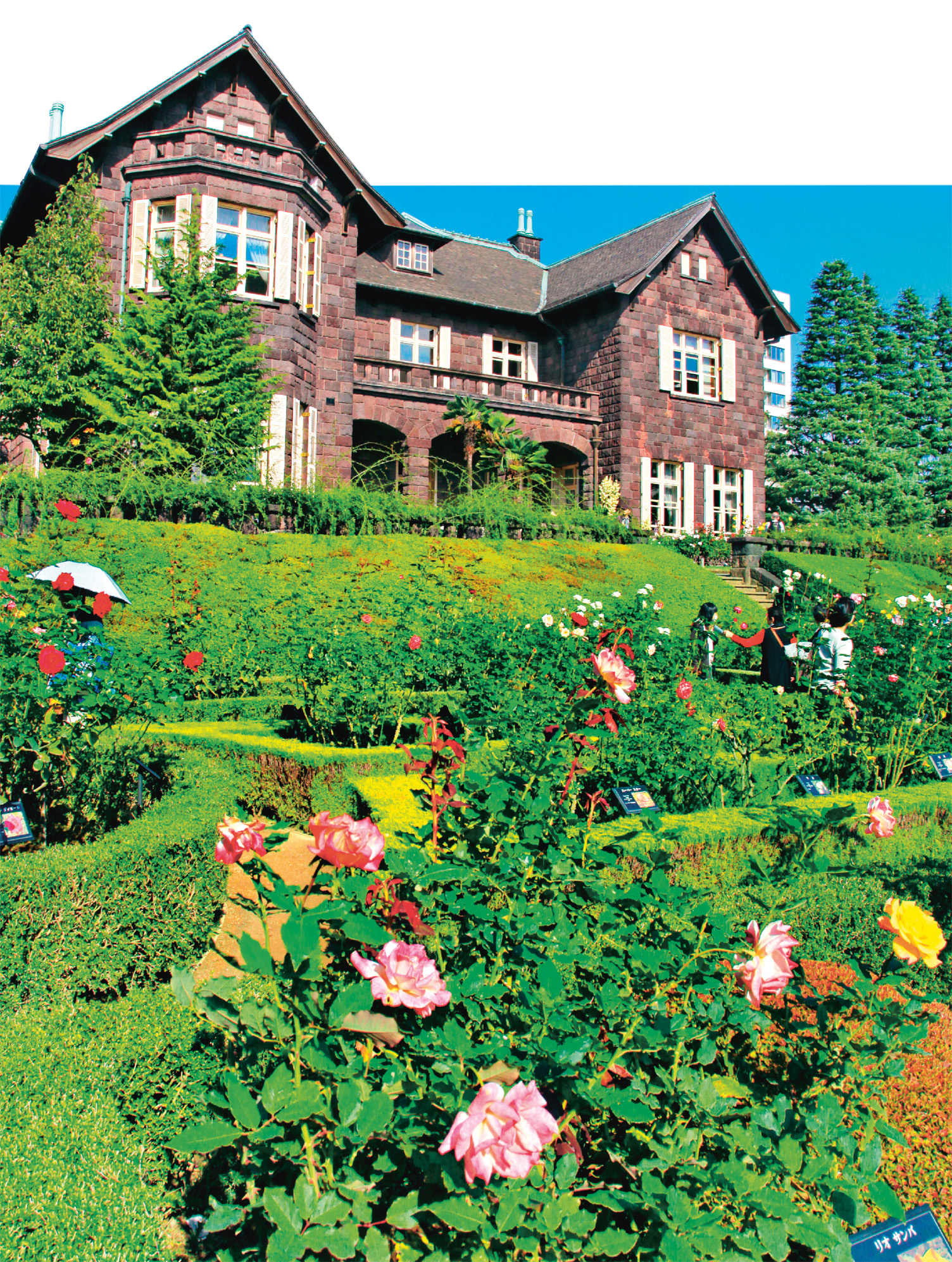
t The charming Kyu Furukawa Teien house with its English-style rose garden
Zoshigaya Cemetery is the resting place of several important literary figures, including Japanese novelists such as Soseki Natsume and Kafu Nagai. The Greek-Irish writer Lafcadio Hearn, whose books helped to introduce Japan to the West in the Meiji era, is also buried here. Scenic tree-endowed graveyards such as Zoshigaya can get crowded during the spring cherry-blossom-viewing season. Another little-visited spot, the Zoshigaya Missionary Museum built in 1907 by an American missionary John Moody McCaleb, is a very well-preserved colonial house, which is open to visitors.
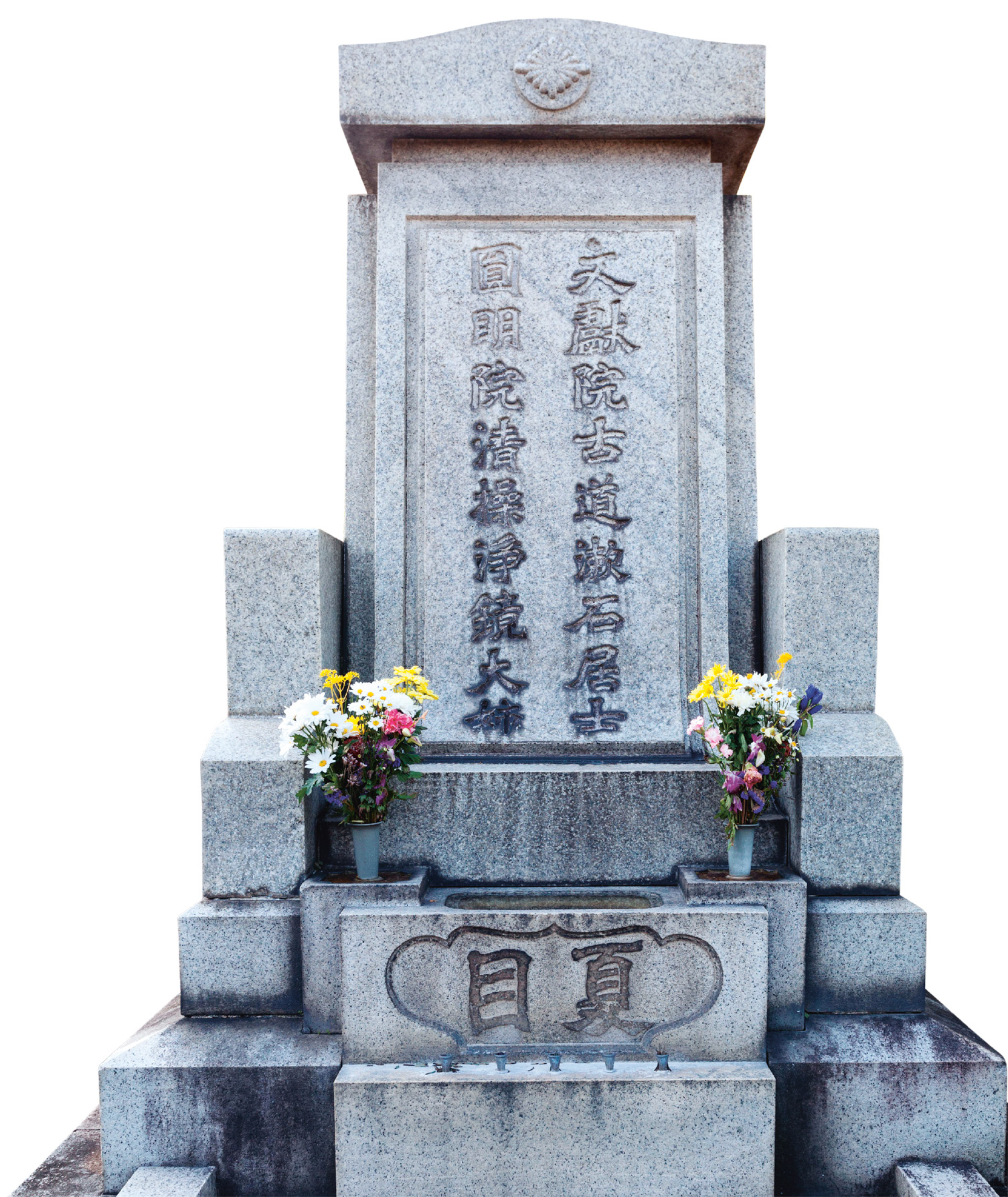
t The grave of writer Natsume Souseki in Zoshigaya Cemetery
Zoshigaya Missionary Museum
⌂ Zoshigaya 1-25-5 # 9am–4:30pm Tue–Sun
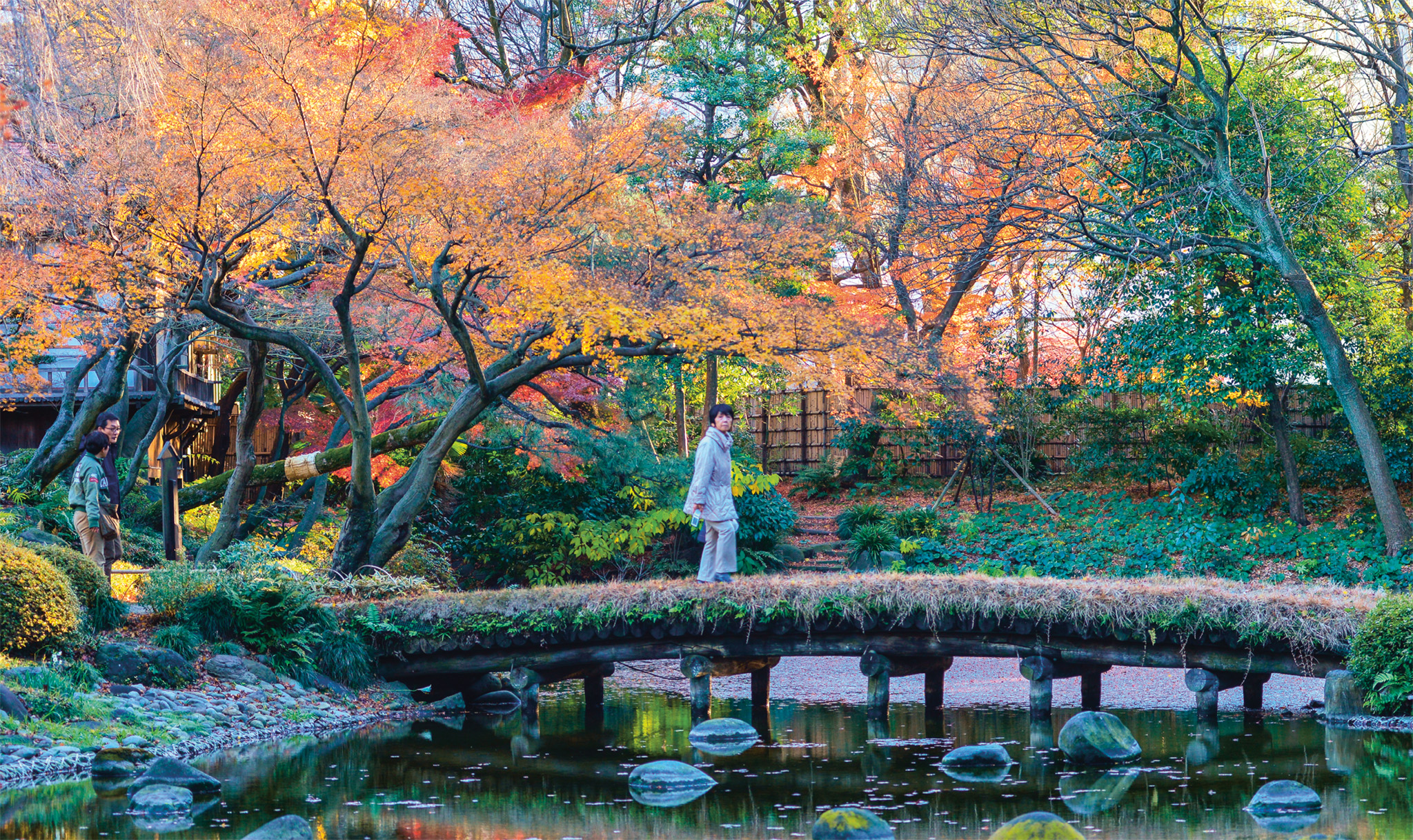
t A bridge crossing a pond in the verdant Rikugi-en Garden
Yanagisawa Yoshiyasu, grand chamberlain of the fifth shogun, built this garden, one of the finest Edo-era stroll gardens, in seven years, from 1695. The fine design recreates 88 landscapes in miniature from famous waka (31-syllable poems), so the view changes every few steps. Sit on one of the many seats and enjoy the views.
A great entertainment and commerce center during the Edo era, Ryogoku is now a quiet place. However, it is still the best place to find the residents who have long made this district famous: sumo wrestlers. Many beya (sumo stables) are here, and it is not unusual to see the athletes walking the streets in yukata (light cotton kimonos) and geta (wooden sandals).
The Kokugikan sumo arena also houses the Sumo Museum, which is lined with portraits of all the yokozuna (grand champions). Beside the stadium is the Edo-Tokyo Museum, one of Tokyo’s most imaginative museums. Two zones trace life in Edo and then Tokyo, as Edo was renamed in 1868. The exhibits have explanations in Japanese and English. The route around the museum starts by crossing a traditional arched wooden bridge, a replica of Nihonbashi. There are life-sized reconstructed buildings, plus scale-model dioramas showing everything from the house of a daimyo (feudal lord) to a section of Shitamachi. Beside a scale model of Tokyo’s first skyscraper is rubble from the 1923 earthquake. Models of the boats that once plied the Sumida River give an idea of just how important the river was to Edo life. In the media section is a step-by-step example of how ukiyo-e woodblock prints were produced.
The Sword Museum is full of fine Japanese swords, some dating back to the 12th century. There is also a display of decorated hilts and old Japanese texts, illustrated with beautiful drawings, explaining the finer points of sword-making.
Opened in 2016, The Sumida Hokusai Museum is devoted to the famous ukiyo-e artist Katsushika Hokusai – perhaps most famous for his print The Great Wave off Kanagawa. The museum has an amazing array of Hokusai’s art as well as videos and multilingual information about the artist and his life.
Sumo Museum
⌂ 1-3-28 Yokoami, Sumida # 10am–4:30pm Mon–Fri ∑ sumo.or.jp
"
Edo-Tokyo Museum
⌂ 1-4-1 Yokoami, Sumida # 9:30am–5:30pm Tue–Sun (to 7:30pm Sat) ∑ edo-tokyo-museum.or.jp
"
Sword Museum
⌂ 1-12-9 Yokoami, Sumida # 9:30am–5pm Tue–Sun ∑ touken.or.jp
" =
The Sumida Hokusai Museum
⌂ 2 Chome 7-2 Kamezawa, Sumida # 9:30am–5:30pm Tue–Sun ∑ hokusai-museum.jp
LIFE IN A SUMO STABLE
At the age of about 15, boys are accepted into a beya. Sumo society is supremely hierarchical, with newcomers serving senior wrestlers as well as cleaning and cooking for the entire beya. Junior practices may start at 4am. The day’s single meal of chanko-nabe, a large stew, comes about noon, with juniors getting what the seniors leave. After, more work follows.
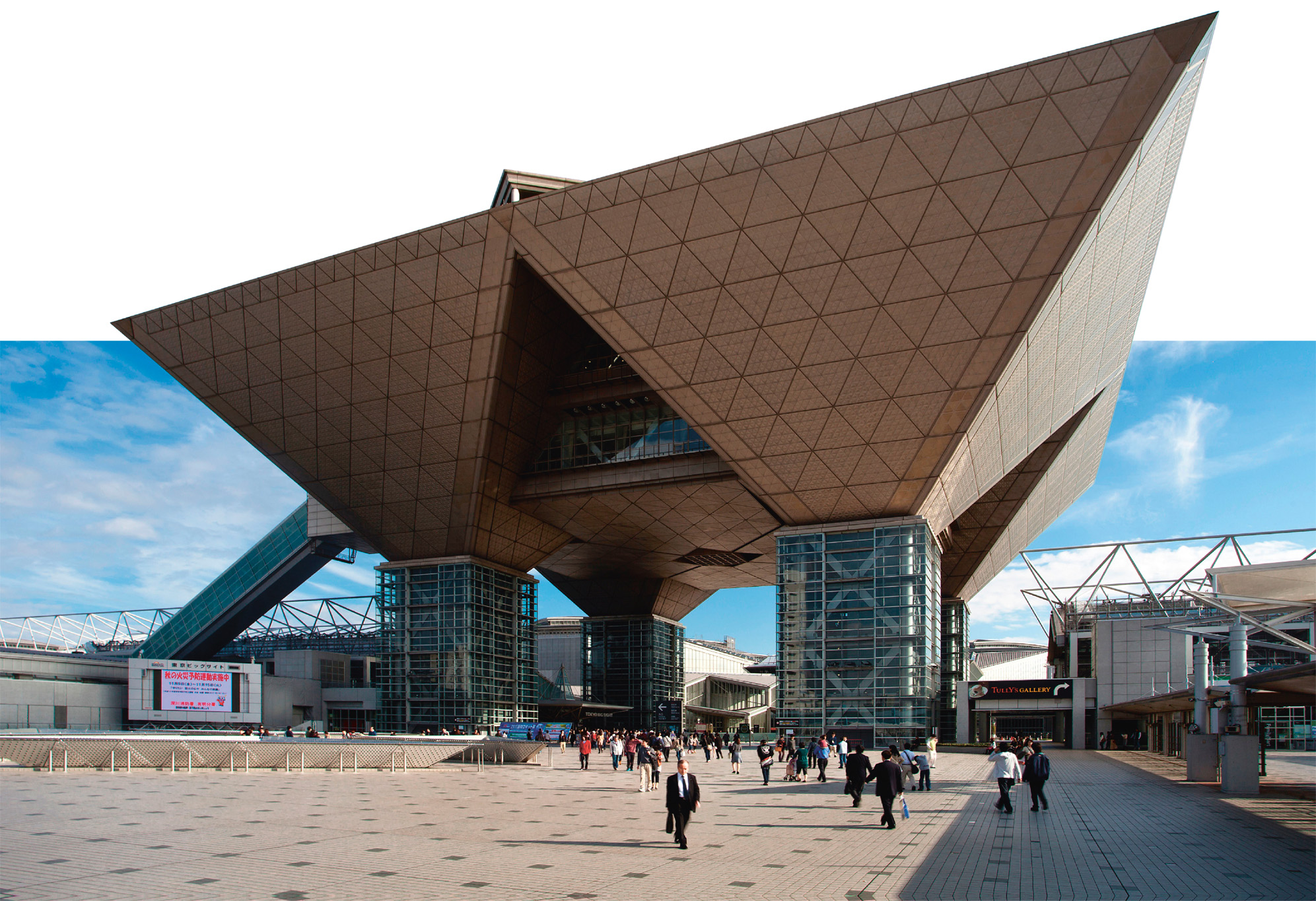
t The distinctive bulk of the Tokyo Big Sight building, in Odaiba
When the West began to force Japan to open up in the 1850s, the shogunate constructed a series of daiba (obstructions) across Tokyo harbor to keep the foreign ships out. Odaiba (sometimes known as Daiba), an island almost blocking the mouth of Tokyo Bay, takes its name from these. The spectacular route to Odaiba is via the Yurikamome monorail, which climbs a loop before joining Rainbow Bridge high over Tokyo Harbor.
The first station, Odaiba-Kaihin-Koen, leads to Tokyo’s only beach. Nearby is the Daisan Daiba Historic Park, with the remains of the original obstructions. A short walk west is Decks Tokyo Beach, which has six floors of restaurants and shops plus Joypolis, a huge Sega center full of the latest electronic games. In front of Decks is the station for water buses from Hinode Pier. Located in Aomi, the National Museum of Emerging Science and Innovation, better known as Miraikan, has interactive robots, biotechnology, and ecological exhibits. The Fuji TV building dominates the area.
At Aomi station is the Palette Town development, including Venus Fort, a shopping mall whose interior recreates an 18th-century Italian town at twilight. Palette Town also includes Mega Web’s Toyota City Showcase, with a massive display area, and state-of-the-art driving simulators. The Wanza Ariake building has shops and restaurants and is connected to Kokusai-Tenjijo Seimon station, as is Tokyo Big Sight (or Tokyo International Exhibition Hall).
National Museum of Emerging Science and Innovation (Miraikan)
⌂ 2-3-6 Aomi, Koto # 10am–5pm Wed–Mon ¢ Dec 28–Jan 1 ∑ miraikan.jst.go.jp
Experience Beyond the Center
|
Stay Hotel Metropolitan Tokyo Ikebukuro Located at the center of the bustling Ikebukuro neighborhood, this is a relaxed and welcoming luxury hotel at an affordable price. Some rooms boast views of Mount Fuji. ⌂ 1-6-1 Nishiikebukuro, Toshima ∑ metropolitan.jp Samurais Hostel Ikebukuro At this kitsch hostel, guests can enjoy classical Japanese art on the walls, as well as glow-in-the-dark samurai murals. Private rooms are also available if you don’t want to share a dorm. ⌂ 3-52-12 Ikebukuro, Toshima ∑ hiromas.net |
Did You Know?
Ukiyo-e prints were usually limited to editions of 100–200 copies
Experience Beyond the Center
THE FLOATING WORLD OF UKIYO-E
During the Edo period (1603–1868), wood-block prints known as ukiyo-e became the most popular pictorial art of Japan. The name (meaning “pictures of the floating world”) comes from the colorful scenes of Edo-Tokyo’s pleasure districts often depicted in ukiyo-e.
THE RISE OF UKIYO-E
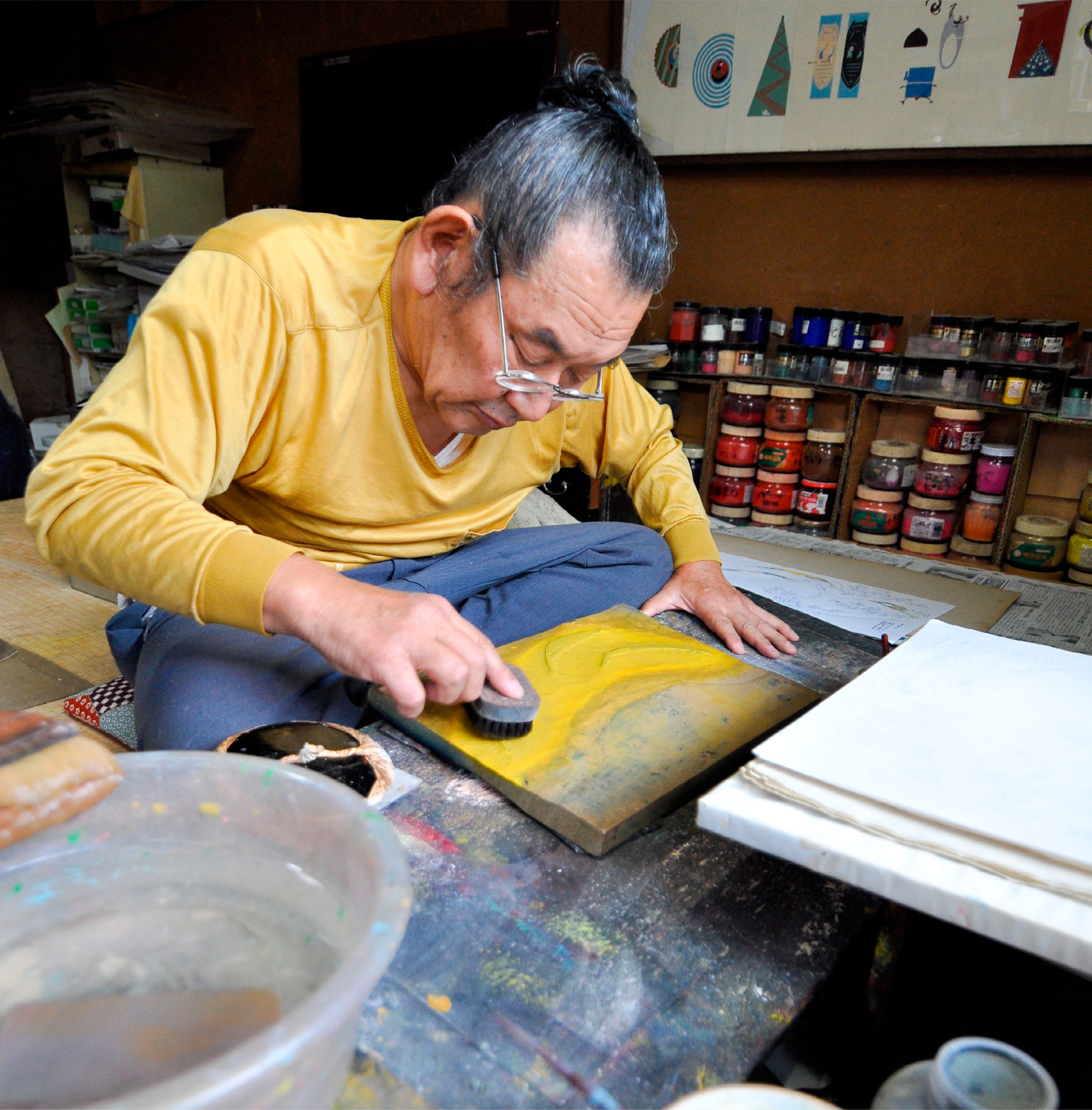
t Kyoto-based woodblock artist and printer Mamoru Ichimura
The first artist known by name was Hishikawa Moronobu (1618–94), whose clean drawing style set the standard for artists to follow. The transition from black-and-white techniques to color came with Suzuki Harunobu’s full-color calendar of beautiful women, published in 1765. The calendar was a great success and attracted both financiers and artists to the medium. Tokyo (then known as Edo) was the center of ukiyo-e production and subject matter, inspiring scenes of daily city life as well as prints of famous Kabuki actors and sumo wrestlers.
When Japan eventually opened up to international trade after its Edo-era isolationism, ukiyo-e were also a big hit abroad, influencing Western art movements such as Impressionism and Art Nouveau, and artists such as Matisse, Manet, and Van Gogh.
MAKING UKIYO-E
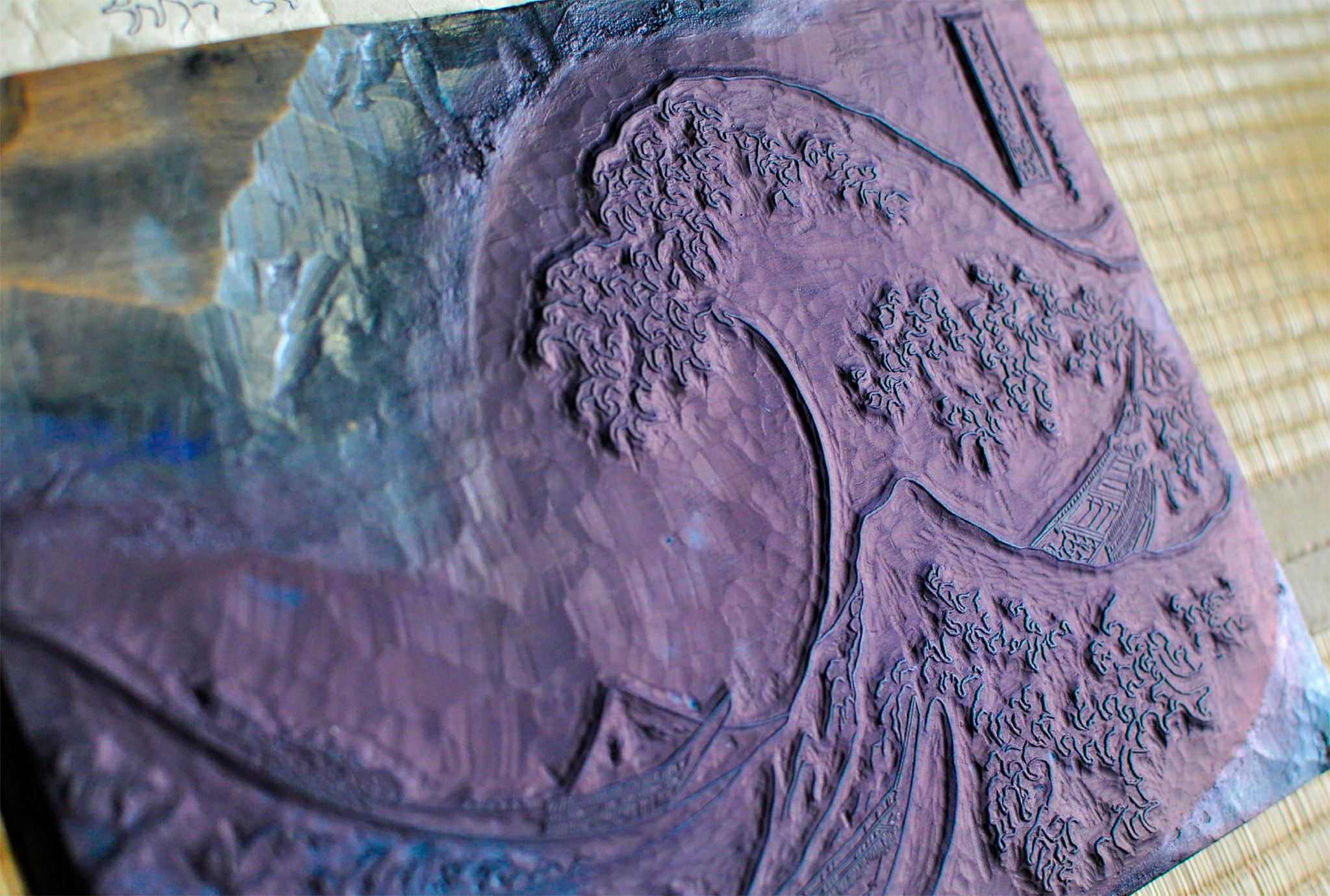
t A carving from artist Mamoru Ichimura’s ukiyo-e studio
Although today they are credited to individual artists, ukiyo-e prints were originally a cooperative effort. The publisher was responsible for financing and distributing the work; the artist produced a fine line drawing; the carver made a wooden block for each color in the image; and the printer created the final product, inking the blocks and pressing them onto the paper – one for each color, starting with the lightest. In the 20th century, artists began to take control of every stage of the process, allowing ukiyo-e to become more personal and expressive than the original commercial prints.
Experience Beyond the Center
THEMES OF UKIYO-E
At the bottom of Edo-Tokyo’s social hierarchy, the chonin (merchant) class developed their own distinct entertainment culture in pleasure quarters known as ukiyo (the “floating world”). Scenes from these vibrant and bawdy districts were the orignal subjects (and namesake) of ukiyo-e, but by the golden age of the medium (around 1790–1850), a number of other themes had become popular, common topics of ukiyo-e.
1. Women

t Three Beauties of the Present Day (c 1792), a famous bijin-ga by artist Kitagawa Utamaro.
Bijin-ga – images of Japanese beauties – were common throughout the development of ukiyo-e. Over-the-top, erotic images (shun-ga) were also popular, and some considered them to be good luck charms.
2. Humor
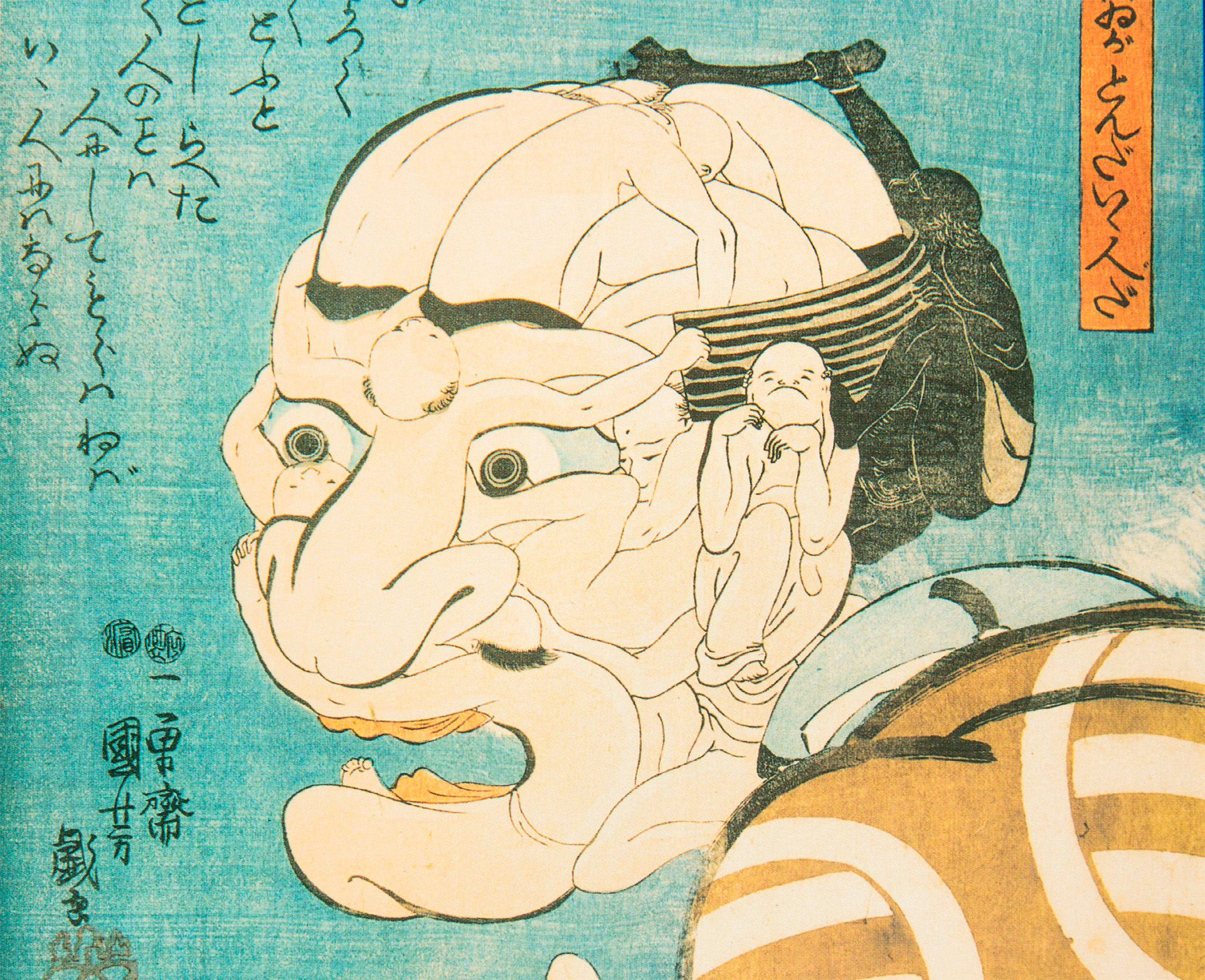
t A toba-e by Utagawa Kuniyoshi (c 1850s), comically-titled Looks fierce but he is a kind person.
Toba-e were humorous caricatures. While these prints were not as prevalent at the time, their legacy is seen in the style, characters, and comedy of early manga.
3. Landscapes

t A print from Utagawa Hiroshige’s landscape series The Fifty-Three Stations of the Tokaido, published between 1833–1834.
Picturesque landscape views (meisho-e) allowed the public to see famous Japanese sights and scenery in an age when few could travel to see the country themselves.
4. History

t Yang Lin, a famous character from Chinese literature, as depicted by Utagawa Kuniyoshi (c 1822–35).
Some of the most vibrantly-colored and detailed prints were those depicting famous samurai, historic battles, and scenes from traditional literature.
5. Celebrities
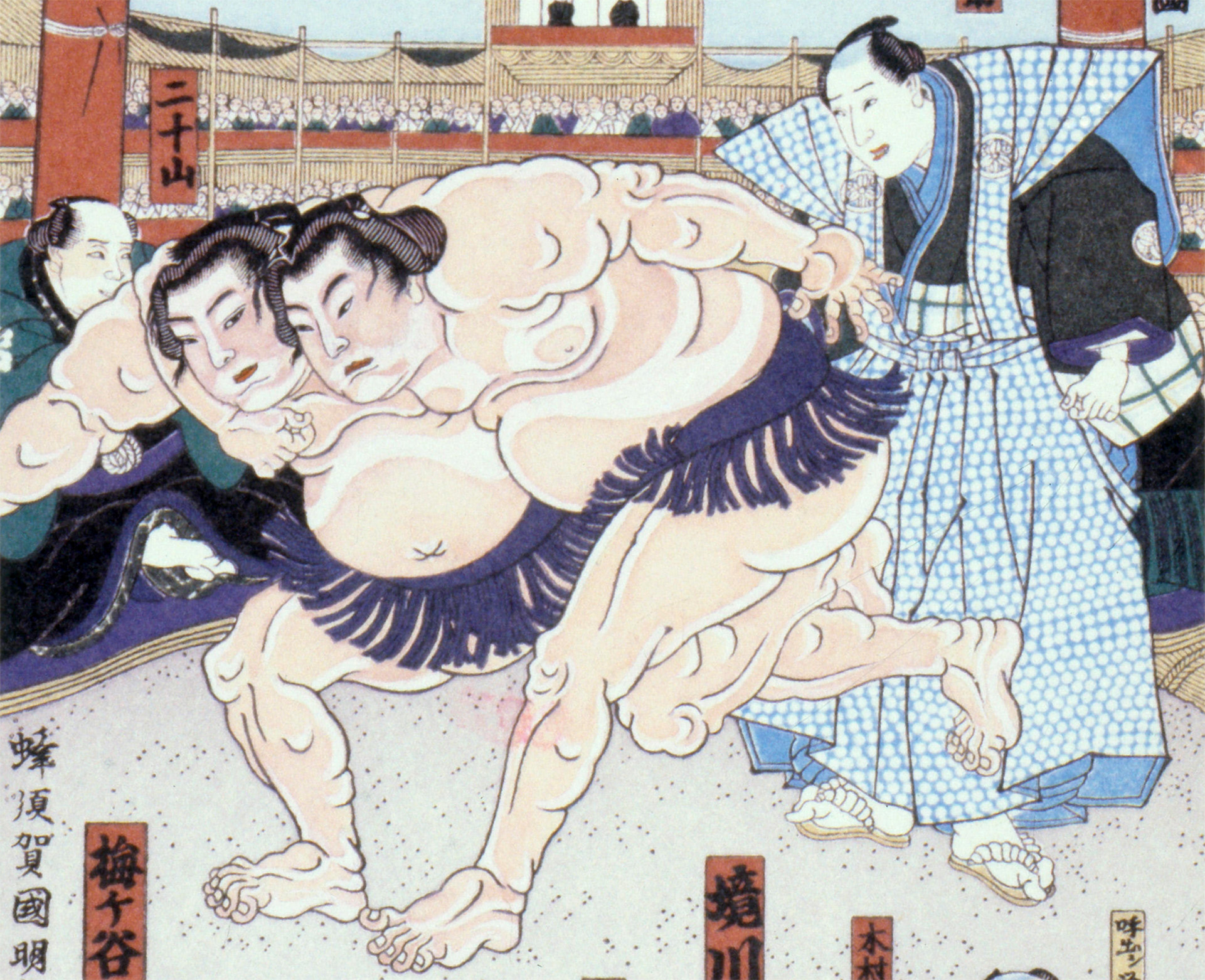
t A 19th century print of a sumo match, by Kuniaki Hachisuka.
As stars of the pleasure districts where ukiyo-e was born, celebrities such as Kabuki actors and sumo wrestlers were often the subjects of commercial prints (yakusha-e).
